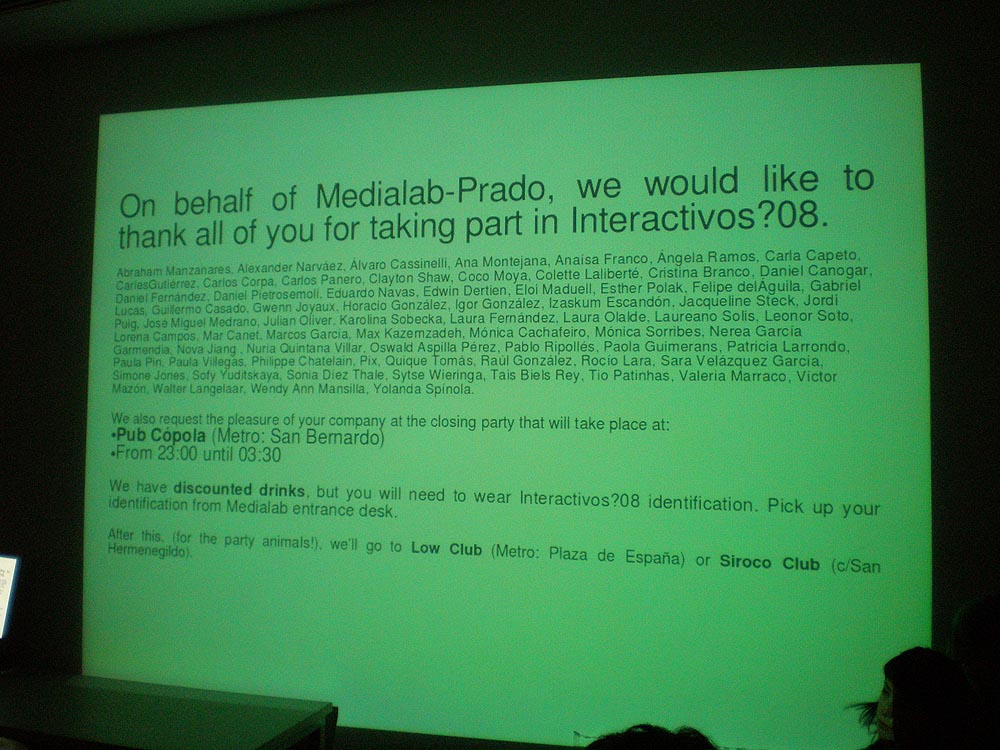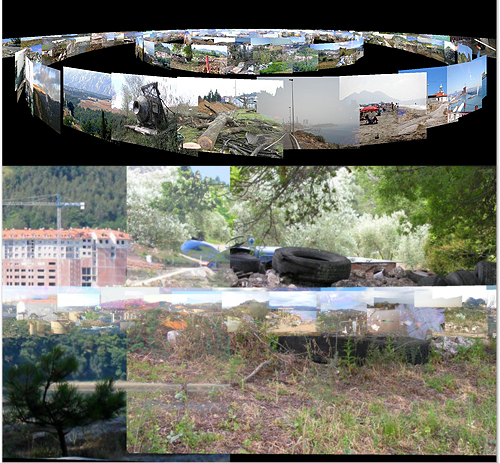The State of Swift Production: Interactivos?’08 (part 2 of 3), by Eduardo Navas

Image: Interactivos?’08 Collaborators, June 14, 2008 (click to view larger image)
See Part 1: https://remixtheory.net/?p=315
The projects for Interactivos?’08 were completed on Saturday June 14, just in time for the exhibition opening scheduled for 6:30 PM. When the project proposals were initially presented during the first two days of the workshops and lectures of May 30 and 31, it was quite understandable if anyone in the audience, and even among the collaborators and artists doubted the completion of the proposals in just two weeks, given their complexity. Fortunately, all projects were up and running.
The key element to meet the deadline was the fact that artists did not work alone, as some people may expect of studio artists, who from time to time might hire or “collaborate” with say a printmaker, or a metalcaster. In Interactivos?’08 collaborators had an incredibly important role to play in, both, decision making as well as actual execution of the works. How much this was so of course varied from project to project, but it is safe to say that there was a certain consensus in the air which was that artists and collaborators live up to the possibility of working together for a common goal, and that they truly contribute in all levels of the creative process, even if some of the work developed did not become part of the final product. Had artists and collaborators not believed this, the selected projects would not have been completed on time, if at all. Upon asking many participants about their role in the overall production of the projects, this sense of contribution was confirmed.
Critiques and informal discussions took place throughout the two weeks, which were extremely important to bring together everyone who participated; and, as would be expected, some fruitful modifications came about.
Image: “Stage Fright” by Nova Jiang
Some projects were more open for interpretation and development than others. For instance, “Stage Fright” by Nova Jiang, was proposed to consist of a swing linked to a movement sensor which sends a signal to a computer to trigger a selected video projection. The footage was edited to go forward and back as the user swings in front of the projection, thus creating a physical relationship between the projected video and the user’s action. This project allowed collaborators to come up with video content of their preference that ranged from shots of dusk till dawn as well as of an Afro-Colombian man swinging upside down, with his hands almost touching the ground.
Image: “Daedalus_ex_Machina [DexM]” by Walter Langelaar
“Daedalus_ex_Machina [DexM]” by Walter Langelaar changed as the artist considered possibilities of both code and the actual space available to exhibit. Langelaar’s initial proposal was a formal and conceptual exercise of the Droste Effect, but as he began to develop the code and talk to various collaborators, he decided to modify the project to be an open ended implementation of the Recursive Descent Parser, which he implemented as a large projection of the Medialab’s entry hall, in the entry hall, itself. The final project shows a detailed 3-D rendering of the Medialab’s entrance, which omits persons who are walking in or out of the lab; however, they appear on the screen inside of the 3-D rendering. The end result is that the Medialab’s entrance repeats everytime, but the viewer who is entering or leaving the space does not appear in the 3-D renderings.
Image: “Immodesty” by Karolina Sobenka
A project open for contribution of content from anyone, especially outside of the Medialab is “Immodesty” by Karolina Sobenka. In this case, however, while there was a lot of input in creating a rig consisting of several digital cameras set up to shoot a sequence reminiscent of the Matrix’s famous Bullet Shot, the actual content, according to the artist, can keep on changing. The installation presents a basic example of the interaction of the viewer and the projection. In “Immodesty,” a movement sensor is also used to detect the position of the viewer within the horizontal space directly in front of the projection. The sensor triggers a projected photo sequence that moves back and forth according to the movement of the user. The footage used for the Medialab presentation was a series of shots of all the collaborators who worked with Sobenka, which gives them prominent recognition in the creative process.

Image: “augment(0)scope” (two views combined) by Eloi Maduel
“augment(0)scope” by Eloi Maduell was open for content development. Maduell envisioned an optical box that presented images from across the world in some abstract form. He was quite open for suggestions because he had not defined the layout of the images as well as the type of images to be presented. In the end he decided to develop social commentary on world pollution. He contacted Greenpeace, who provided him with a large database of images. The majority of the images were landscapes, which allowed Maduell to categorize and assemble the images as a large spiral that can be navigated freely while viewing inside the visual box through a small whole. The viewer decides where to go in the virtual space by moving back and forth the special handles located on both sides of the device.
Image: “Spiral Drawing” by Esther Polak
The rest of the projects stayed close to the original proposal only allowing collaborators to contribute mainly in problem solving. “Spiral Drawing” by Esther Polak, which consists of a robot that moves in the form of a spiral, fast if the sunlight is bright or slow if the sun is dim, was very much executed as originally described in the proposal. Polak considers the work to allude to our current concerns of global warming. Selected drawings as abstract documents of the process were shown inside the gallery, while the actual sand drawing was shown in the courtyard.
Image: “M.A.S.K. (My Alter Self Konsciousness)” by Jordi Puig
M.A.S.K. (My Alter Self Konsciousness) by Jordi Puig allowed for quite a bit of problem solving in terms of code writing and debugging, but like Polak’s the project also stayed close to the original concept.
Image: “Expanded Eye” – Anaísa Franco
The same is true for “Expanded Eye” – Anaísa Franco, which consists of the viewer’s eye (left or right, depending on the viewer’s choice) to be projected inside of a transparent sphere. With each blink the eye multiplies and very shortly the visitor finds herself viewing hundreds of reproductions of her eye. The viewer essentially is looking at herself.
Image: “360º score” by Philippe Chatelain (artist working with installation drawing in the background)
“360º score” by Philippe Chatelain is also quite close to what the artist envisioned. Chatelain also originally wanted to create a sound installation defined by, both, how the viewer moved across the room as well as how the viewer manipulated manually a laser which read an abstract geometrical drawing in order to produce sound. For the installation at the Medialab, Chatelain opted to develop the former.
Image: “Biophionitos” by Paola Guimerans, Horacio González, and Igor González (wooden box for exhibition being constructed, just hours before exhibition’s opening.)
“Biophionitos” by Paola Guimerans, Horacio González, and Igor González also stayed true to the original proposal. Collaborators found creative possibilities in developing text copy and translating it to English as well as shooting and editing an instruction video which showed how to create your own smart pet with basic materials such as cardboard and glue. The idea behind Biophionitos is to create an updated version of a Zoetrope which presents an interactive animation of a “virtual pet” that reacts to the person’s speech and proximity.
Image: “BLOOP” by Martin Nadal
Finally, “BLOOP” by Martin Nadal is another project that stayed close to the original premise. The user can choose a still from a video sequence to then draw on it with an interface similar to design programs like Photoshop and Illustrator. Once the still is adjusted as desired, the user can choose to view the video sequence, which consists of frames that have been altered by various gallery visitors. Nadal eventually would like to develop further the project so that online users can also contribute their own video, to then allow others to draw on each frame as described above.
As previously stated, it is quite remarkable that all of these projects were developed in just two weeks. Medialab-Prado has created a platform where artists can come together and develop work in a very short period of time. How successful each project may be in the long run can only be decided with reflection and openness to the ongoing discourse of art practice. Artists and collaborators of Interactivos?’08 are aware of this, and many of them opted for calling their projects “prototypes” which can be improved in the near future. Interactivos?’08, then, successfully brings together many of the key elements that make new media production so appealing to contemporary art practice. Medilab-Prado understands the importance of global collaboration, but most importantly, it understands that bringing together people who may live in different parts of the world to a local setting to collaborate may be the best way to foment international relations through local investment.
Interactivos?’08 Collaborators:
Abraham Manzanares, Alexander Narváez, Álvaro Cassinelli, Ana Montejana, Anaísa Franco, Ángela Ramos, Carla Capeto, CarlesGutiérrez, Carlos Corpa, Carlos Panero, Clayton Shaw, Coco Moya, Colette Laliberté, Cristina Branco, Daniel Canogar, Daniel Fernández, Daniel Pietrosemoli, Eduardo Navas, Edwin Dertien, Eloi Maduell, Esther Polak, Felipe delÁguila, Gabriel Lucas, Guillermo Casado, Gwenn Joyaux, Horacio González, Igor González, Izaskum Escandón, Jacqueline Steck, Jordi Puig, José Miguel Medrano, Julian Oliver, Karolina Sobecka, Laura Fernández, Laura Olalde, Laureano Solis, Leonor Soto, Lorena Campos, Mar Canet, Marcos García, Max Kazemzadeh, Mónica Cachafeiro, Mónica Sorribes, Nerea García Garmendia, Nova Jiang , Nuria Quintana Villar, Oswald Aspilla Pérez, Pablo Ripollés, Paola Guimerans, Patricia Larrondo, Paula Pin, Paula Villegas, Philippe Chatelain, Pix, Quique Tomás, Raúl González, Rocío Lara, Sara Velázquez García, Simone Jones, Sofy Yuditskaya, Sonia Díez Thale, Sytse Wieringa, Tais Biels Rey, Tio Patinhas, Valeria Marraco, Víctor Mazón, Walter Langelaar, Wendy Ann Mansilla, Yolanda Spínola.
Medialab Prado’s Main site: http://medialab-prado.es/
Interactivos? main website: http://www.interactivos.org/
List of projects with proper descriptions: http://medialab-prado.es/article/interactivos08_-_juegos_de_la
_vision_lista_de_comunicaciones_y_proyectos_seleccionados
Medialab Flickr: http://www.flickr.com/photos/medialab-prado/
Medialab Wiki: http://wiki.medialab-prado.es/index.php/Main_Page
Other lines of work, year round:
Visualizar: http://medialab-prado.es/visualizar
Inclusiva: http://medialab-prado.es/inclusiva-net
Commons Lab: http://medialab-prado.es/laboratorio_del_procomun
AVLAB: http://medialab-prado.es/avlab2
Lascia un commento
You must be logged in to post a comment.








